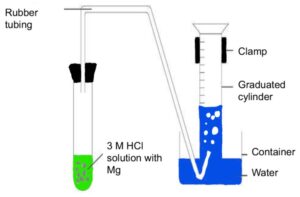Gas Laws with H₂ (In Person)
VIDEO LINKS:
Lab Experiments (Write protocols and perform experiments based on these):
Data analysis and calculations (Use these if you need help with your data and interpretations)
The prelab must include Experimental Protocol, Chemical Table and Equipment Table.
The lab report requires all sections (including prelab sections) to be completed in one document.
Experimental Protocol
(Analysis) Watch the experiment videos. Take notes on the protocol. Stop the video and re-watch as necessary to acquire the details of the procedure. Write out the protocol for each part of the experiment. (It can be written in sequential steps. Complete sentences are not necessary.) This is the protocol you will follow, so be detailed.


Chemical Table
(Representation) Prepare your chemical table including the materials you will use in the experiment. Here is a general template that you may use.
| Chemical Name | Chemical Formula | Molar Mass (g/mol) | Hazards | Reference | PPE |
| Sodium Chloride | NaCl | 58.5 | Skin irritation | https://fscimage.fishersci.com/msds/21105.htm | |
Equipment Table
(Analysis) Identify the equipment (type AND size) needed for the experiment and include the name and an image of each. Be sure to describe the equipment, how to use it, and why it is suitable for this use.
| Equipment Name | Equipment Picture | Intended Purpose |
Data Collection
(Acquiring competencies) Following your detailed protocol based on the videos, perform all the experiments. Record your observations and take pictures of your key steps in the process. Your observations and images need to be incorporated in your data section and this section should be as detailed as possible as you will use this information to complete your discussion.
Data Processing
- (Representation) Write the balanced chemical equation for the reaction between the magnesium strips and the hydrochloric acid solution.
- (Interpretation) Describe the meaning of the chemical equation on the microscopic (atoms/molecules/formula units) and macroscopic scale (moles).
- (Manipulation) Calculate the moles of hydrogen gas expected from the reaction of HCl with Mg. Use stoichiometry, appropriate units and consider the significant figures.
- (Manipulation) Calculate the actual moles of hydrogen gas produced using the collected volume of gas. (HINT: the gas was collected over water.)
- (Manipulation) Calculate the % yield of the reaction. [Actual moles of H2(g)/expected moles of H2(g)]×100%
- (Assumptions and Analysis) Fill in the following table using the observations and data from your experiments.
| Assumptions made | Testing the assumption | If assumptions are wrong ... |
| All the acid will be consumed in the reaction. | ||
Discussion
Write a minimum one-page (12 font, single spaced) discussion on the experiment conducted this week. Address at least one question in each category as fully as possible integrating the collected data, providing explanations for the observed trends, and evaluating whether your original assumptions about the experiment were validated by the results. The assignment will be graded on completeness, clarity of the explanations and the meaningful integration of the collected and calculated data. Correct grammar and appropriate format for the chemical formulae and chemical reactions is expected.
- (Analysis) Classify the observed chemical reaction into as many categories as you can justify with supporting evidence.
- (Existing knowledge, research, and views) Provide at least 3 additional examples for gas forming reactions and provide a reference for your source.
- (Analysis) Identify at least one similarity and at least one difference among the gas forming reactions that you encountered.
- (Existing knowledge, research, and views) Define ideal gases in your own words and describe the conditions under which a gas will behave as an ideal gas. Provide a reference for your source.
- (Existing knowledge, research, and views) Identify the position of magnesium and hydrogen on the activity series and provide a reference for the activity series that you used to establish those positions.
- (Analysis) Using the positions of the magnesium and hydrogen on the activity series, predict if the reaction between the magnesium ribbon and the hydrochloric acid solution should proceed.
- (Analysis) Compare the observed reaction between the magnesium ribbon and the hydrochloric acid solution to your earlier prediction about the reaction based on their positions in the activity series. Comment on whether the observations are consistent with your expectations.
- (Assumptions and limitations) Identify at least one assumption that you made about H2 being suitable for this experiment. (Hint: consider polarity and solubility in water.) If this assumption is not valid, describe how it impacts the volume of the gas collected in the experiment.
- (Analysis) Propose at least two other gases that would be better suited for such and experiment and two gases that would be worse. Support your choices with relevant information about the proposed gases.